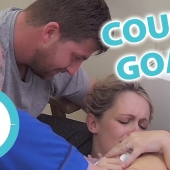When it comes to give birth most women want to know how much it is going to hurt and will I be able to cope with the pain. Unfortunately no one can answer each of these questions of certainty, but what you can do is improve your ability to cope with pain during labor as well as understand your options for pain relief and their impact to your labor and baby.
Labor can be painful so it's important to learn about all the ways that you can relieve the pain. It's also helpful for whoever is going to be with you during your labor to know about the different options as well as how they can support you.
You may wish to discuss with your midwife what's available at the hospital birth center or home so that you can decide what's best for you. Write down your wishes in your birth preferences but remember that you should keep an open mind.
You may find that you want more pain relief than you plan or cope better than you had expected. They will make a huge difference to how you feel during labor. Emotional support such as encouragement and reassurance from somebody you trust can really boost your confidence and ability to cope with pain when you need it most. Knowledge is the key in helping you feel in control and remain calm.
Understanding that adrenaline works with you to stop or halt and slow your labor when you need it to such as for the car journey to the hospital. Nobody wants to have a baby on a busy dual carriageway in rush-hour traffic but we do have large quantities of oxytocin that love hormone running through your body enabling you to make the progress your body wants and shorten the labor, therefore reduce the adrenaline running through your body.
You need to feel relaxed calm and trust in the knowledge that your body will do what it is designed to do. Learn about labor this can make you feel more in control and less frightened about what's going to happen. If you are less frightened that means less adrenaline. Talk to your midwife or doctor and ask them questions learn how to relax stay calm and breathe deeply, keep moving.
Your physician can make a difference so try kneeling, walking around or walking backwards and forwards. Ask your partner to massage you although you may find that you don't want to be touched.
Have a bath so let's look at the different pain relief options that are available during labor. Lying on your back commit your contractions slower and more painful movement such as rocking swaying and leaning forward maximizes your body's ability to give birth as it helps ease your baby along the birth canal.
There is no lasting side effects for you or your baby however try not to overdo it, saving energy is also important. Lying on your side for a while or setting up supported by lots of pillows can help your body to work really well while you conserve energy.
This stands for transcutaneous electrical nerve stimulation attempt machine transmits mod electrical impulses to pads on your back. These block pain signals and help your body to produce its own natural painkillers called endorphins. It also reduces the number of pain signals that are sent to the brain by the spinal cord.
Some hospitals have tens machines so it's worth inquiring if you think you would like to try one if not you can hire a machine speak to a friend to see if they have one. You could borrow or alternatively you could buy one yourself. Tens have not been shown to be effective during the active phase of labour, when contractions get longer stronger and more frequent.
It's probably most effective during the early stages when many women experience low back pain. This tends to be the time you are still at home in the early stages of labor or if you plan to give birth at home.
If you're interested in tens learn how to use and have one available from around 30 several weeks of your pregnancy. Tens does not eliminate the pain but can make it more manageable. You can keep moving and it won't directly interfere with your labor it is non-invasive. There are no known side effects for you or your baby it doesn't need an anesthetist doctor or Midwife. It can be used at a home birth and in hospital.
You will need someone to help you to position the tens. It may only help in the early stages of labor. They may have to be removed if your baby's heart to be monitored electronically. You can use tens before you get into water but not when you're in the water. It might make it more difficult for your birth partner to massage your back.
Some women prefer to avoid the types of pain relief traditionally talked about and choose alternative treatments such as acupuncture, aromatherapy, homeopathy, hypnosis, massage and reflexology. Most of these techniques are not proven to provide effective pain relief. If you'd like to use any of these methods it is important to discuss them with your Midwife or doctor and let them know beforehand.
Most hospitals don't offer them for pain relief during labour so if you want to try any of these techniques make sure that the practitioner is properly trained and experienced. There is little research proven the effectiveness of these treatments. Though lots of women say that they found these techniques useful.
Apart from massage and self-hypnosis you will need a registered practitioner to the form of therapy massage or pressure on the lower part of your back can also help reduce levels of stress and ease discomfort. You can also learn self-hypnosis and relaxation techniques for labor.
Water can help you relax and make the complexion seem less painful. It also supports you enabling you to adopt any position. Whilst at home you can have several baths throughout early labor and if you are attending the hospital or birthing unit you can ask to use the bar or use a birth tool. If available the water should be kept at a comfortable and appropriate temperature. You can combine the use of water with other options such as entinox and massage. Women who labor in water need few interventions and are less likely to need other drugs.
However water can sometimes slow down labor particularly if you get in too early, you won't be able to use tens, opioid based analgesia or an epidural while you're in water. When you call the unit to say that you're in labor, this is a good time to identify your wish to use a birthing tool. Please remember that they will not be available if they are already in use for home birth. Birthing pools can be hired.
This is a mixture of oxygen and nitrous oxide gas gas and it won't remove all the pain but it can help to reduce them and make it more bearable. Many women like it because it's easy to use and they control it themselves. It works by breathing in the gas on air through a mask or mouthpiece which you hold yourself.
The gas takes about 15 to 20 seconds to work so you breathe it in just as a contraction begins. It works best if you take slow deep breaths and the effects well very quickly once you stop inhaling. There are no harmful side effects for you or the baby but it can make you feel light-headed. Some women also find that it makes them feel, sick sleepy or unable to concentrate. If this happens you can stop using it.
However these feelings usually part rather quickly after your body gets used to it. Entonox can dry your mouth out tips of water may be useful. Entonox is available for all that in all birth settings and can be used alongside and in addition to most other forms of pain relief. These are pain-relieving drugs given by injection or a drip.
Opioids may help you to relax and get some rest especially if your early labor has been long and uncomfortable. Most opioids can be given within a short time of your request for pain relief. It begins to work within about 20 minutes. Research suggests that if you're already an established labor these drugs don't appear to slow labor down.
They may help you to postpone or avoid having an epidural. If you're finding your contractions hard to cope with it is still possible to use a birth pool or bath during labor. That is not recommended within two hours of a single dose of an opioid or whilst you're still drowsy. Protocols vary so it's good to check with your Midwife if you are considering using opioid drugs in labor.
Once you've had an opioid the effects can last up to four hours. You may feel out of control, drowsy and/or detached. If you don't like the sensations you can't do anything about it until it wears off. You may feel sick an anti sickness drug is usually given at the same time to combat this. All opioids transfer through the percentage of the baby they can occasionally make them slow to take their first breath. Opioids may make your baby more reluctant to feed in the first 24 hours.
Epidurals numb the nerves that carry the pain impulses from the birth canal to the brain. For most women it is the most effective method of pain relief and no additional pain relief should be required. An epidural is only available if you choose to give birth on the labor board and is administered by an anesthetist.
To have an epidural you will need to have IV access which means a cannula will be inserted into a vein in your arm or hand. This is in case drugs or fluids need to be administered quickly. While you lie on the side or sit up in a cold position and anesthetist will clean your back with an antiseptic. Numb a small area with some local anesthetic and then introduce a needle into your back.
A very thin tube will be passed through the needle into your back near the nerves that carry pain impulses from the uterus. Drugs administered through the tool, it takes about 20 minutes to set up and insert the epidural and another 20 minutes for it to work. It doesn't always work perfectly at first and may need adjusting after it has been set up.
The epidural can be topped up by your midwife or you may be able to top up the efficy of yourself through a machine. You will need to have increased monitoring for your blood pressure your contractions and the baby's heart rate may need to be monitored continuously.
There are some side effects to be aware of an epidural may not work well enough to reduce labor pains. One in eight women an epidural may make your legs feel heavyi your blood pressure can drop. However this can be resolved by giving fluids or drugs through the cannula in your arm or hand which will help to maintain a good blood pressure.
Epidurals can prolong the second stage of labor if you can no longer throw your contractions. The Midwife may have to tell you when to push this increases the risk of forceps or avanti's being needed to help deliver the baby's head known as an instrumental delivery. When you have an epidural your midwife or doctor will wait longer for the baby's head to come down before you start pushing. This reduces the chance that you will need an instrumental delivery.
Sometimes less anesthetic is recommended towards the end so the effect wears off slightly and you can push the baby on naturally you may find it difficult to pass urine as a result of the epidural. Removing sensation plus if your legs are heavy you will be unable to watch the toilet.
Therefore it may be advised that a small tube called a catheter be put into your bladder to help you as it is important to keep your bladder empty during labor. About one in a hundred women gets a headache after an epidural. If this happens it can be treated. Some low dose epidurals don't contain less anesthetic but include a small amount of fentanol and opioid drugs.
The fentanol makes the epidural really effective without taking away all of your mobility, but the fentanol may cross the plasenta and make the baby sleepy. Studies have identified different feeding behaviors in babies born after low dose epidurals we used. Your back might be a bit sore for a day or two so epidurals don't generally cause long term back problems.
About 1 in 2,000 women feel tingles or pins and needles down one leg after having a baby. This is more likely to be the result of childbirth itself rather than the epidural. The type of care relief you choose is your choice. You may wish to visit NHS Choices website, discuss this with your midwife.
But look at the information in your handheld note, do what feels best for you. Every labor is different and each women should choose whatever she needs to help her cope with the pain of labour. Most importantly have confidence that you can do it.
- 24627 views













